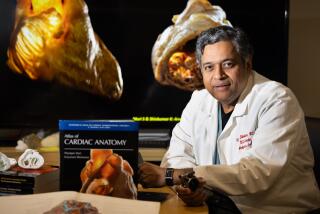THE WISDOM OF THE BODY: Discovering the Human Spirit.<i> By Sherwin B. Nuland</i> .<i> Alfred A. Knopf: 395 pp., $26.95</i>
- Share via
In a mood ironic and a mode iconic, novelist Kurt Vonnegut refers to our bodies as “meat”: bitterly ironic, for Vonnegut is distraught at the violence we have done to each other in the flesh; iconic because that violence has been enabled by our willingness to isolate body from heart, body from mind, body from soul.
When surgeon Sherwin B. Nuland sees meat, he thinks of blood and life and Deuteronomy 12:23: “for the blood is the life; and thou mayest not eat the life with the flesh.” He remembers his mother draining the blood from meat--making it kosher as an Orthodox Jew must--and what he draws from this memory is the lesson of “the legendary power of blood.” Blood is everywhere in “The Wisdom of the Body”--seeping, spurting, circulating--but the body is not meat. What Vonnegut handles with an irony as deliberate as it is scathing, Nuland handles with a breathless adoration. Those indeed are the final words of this biology book for the general reader: “Like the wisdom of the body, the real and potential magnificence of the human spirit must be approached not only with wonder but perhaps also with the awe-struck attitude of Wordsworth’s nun on a beauteous evening: “Breathless with adoration.”
Were it not for such a breathless tone, Nuland’s 395 pages would scarcely escape from the realm of the textbook. What redeems his long expositions of the lymph system, nervous system, reproductive system, circulatory system, etc., is less the economy of his syntax than the organization of the whole. Everything fits together so neatly.
That’s more than a matter of style--it’s the point of the book. In Vonnegut’s works, our chaotic outer world falls into place by the most extraordinary of coincidences. In “The Wisdom of the Body,” our turbulent inner world writhes in dynamic equilibrium or, as Nuland writes at the beginning of his second chapter, the “constant sea within maintains the constancy within” by the most amazing of evolutionary and biophysical instances, all pulling together on our behalf. What the 19th century French physiologist Claude Bernard called le milieu interieur, and what Nuland translates as our internal environment, is organized so perfectly as to accommodate almost every challenge from our external environment.
Nuland himself is writing within three literary environments. The first is the clinician’s meditation, a genre that, in English, dates back to Robert Burton’s “The Anatomy of Melancholy” of the 1620s and continues today in the essays of Oliver Sacks. Clinicians rely on personal experience, grounded in anecdote, biography and autobiography, to make their diagnoses and, in literature, to make their case. Nuland’s anecdotes in “The Wisdom of the Body,” unfortunately, are strained or cloying. Nuland’s case studies are better, for he dares to reveal his ambivalence about his patients and he quotes from their own accounts before and after surgery. Nuland’s autobiographical episodes are the best and the worst, for no matter how hard he tries to make his personal experiences paradigmatic of the balancing act of the body, the episodes invite us to wonder rather at the skill of the surgeon.
Which leads us to the second genre: the history of medicine written by physicians. With rare exceptions, such histories have been celebratory of the profession and unwaveringly optimistic about prospects for more startling discoveries, more sophisticated tools, more effective pharmaceuticals. “The Wisdom of the Body” is no exception. However much Nuland seems disposed to direct our attention toward his patients, he draws us back time and again to be impressed by the historic insights of the fathers of medicine and by the contemporary dedication, responsiveness and intelligence of the surgical teams he leads or, in the case of a heart transplant, observes. Nuland asserts more than once that patients survive by force of some mysteriously intact will or spirit, but what he shows us is one patient after another living by force of his will and the supreme coordination of his surgical teams.
The third genre is that of holistic philosophy, which makes of the body itself a finely coordinated team of organs and chemical compounds, whose whole is greater than the sum of their parts. Holism had its first modern heyday in the 1920s and 1930s in physics, sociology, zoology and biology. Americans owe their notions of ecology and of social welfare to the blossoming of holism, a philosophy reapplied to medicine late in the 1970s. Nuland keeps a careful distance from New Age holistic medicine, but he puts himself squarely within the older holistic tradition with the title of his book, which repeats the titles of a 1923 oration by Ernest Starling, co-discoverer of hormones; a 1931 book by Walter B. Cannon, authority on the body’s autonomic regulatory systems; and a series of lectures in 1937-38 by Sir Charles Sherrington, investigator of the nervous system. Sherrington, in particular, inspires Nuland, for it was Sherrington who spoke unabashedly of wonder as the mood in which he would approach the body.
Such a mood, adopted by Nuland, is reminiscent of early modern arguments for the existence of a deity on the basis of the otherwise-incredible coherence (or clockwork regularity) of the universe, but Nuland wants to work in quite the opposite direction. His astonishment is focused upon the complexly organized set of systems, cells and molecules through which we have, and make, our lives. The body is like an ideal society, Nuland writes; slowly, his simile slips toward metaphor and from metaphor to motif: The body truly is an ideal society--self-constituting, self-directed, incessantly intercommunicative, instantly responsive and, for the most part, self-repairing. The physician’s role, writes Nuland (resorting to an inept analogy with boxing), is that of cornerman, fixing just enough so that the body may battle on.
Nuland’s humility rings false at each round. Through detailed accounts of his surgical battles with a bleeding spleen, breast cancer, sickle cell anemia and intestinal viral infection, he wants his readers to come to an appreciation of the “constantly compensating alterations” by which our bodies with relative calm keep us going. Instead, we come upon his calmness, his resilience, his soft-spoken decisiveness.
Five times in this review I have italicized his, with cause. All but one of the physicians in this book are male (a woman surgeon appears in passing). Like Nuland, most are as self-assured as they are soft-spoken. The two-dozen scientists, novelists, essayists, poets and playwrights quoted in this book are male. Aside from an intake person, several nurses and one heart transplant coordinator, the past and present of medicine is male. Although a substantial number of Nuland’s exemplary cases involve women (whose words he quotes at length) and although he makes pleas on behalf of natural childbirth and compassionate breast exams, the holistic world in which he operates is essentially a man’s world. There may be, as he argues, no dualities. Mind and body, mind and soul, may be categories indistinct and indefensible; even so, we see no sign yet in this surgeon’s world of men and women in equal partnership.
Indeed, one can read this book as belonging to yet another genre, that of the organization man waxing philosophical. When Nuland honors the women he treats, he admires their compliance with harrowing protocols and their willingness to submit to the complex organization of medical practice. He has trouble with men who are disrespectful of that organization and will not be compliant, especially one “Mr. Trouble,” who forces Nuland’s hand and demands the removal of an anal polyp in unwise circumstances. Nuland acquiesces against his better judgment. Mr. Trouble is trouble because he has taken authority away from Nuland and, for a moment, he has become the brains of the operation.
Brains themselves are big trouble. Nuland admits that we have a great deal to learn about the brain, but he is certain that when all is dissected, we will know its neurophysiology well enough to be able to explain how “meat” makes mind. The fantastically intricate organization of our physiological systems, combined with the “equilibrium and harmony of all the struggle for constancy within our biology,” makes us who we are, not just what we are. Reason, judgment, memory and personality proceed from the body. Linked nerve to nerve, cell to cell, all the parts of us constitute our mind. From that continuum arises what is called spirit, “the generated product of our innate biology, encompassing the molecular behavior of our cellular structure. Nothing more need be sought.”
It’s like a good poem, Nuland suggests. Each word and image in its place, the rhythm apt to the meaning, something happens along the rise and fall of the meter that is otherwise inexpressible and for which we invoke a muse. Invoke divinity if you must, writes Nuland. He is happy enough with his hands and his head “deep within the body of humanity.” No irony here, and nothing much a god can do that we, or he, cannot.
More to Read
Sign up for our Book Club newsletter
Get the latest news, events and more from the Los Angeles Times Book Club, and help us get L.A. reading and talking.
You may occasionally receive promotional content from the Los Angeles Times.







